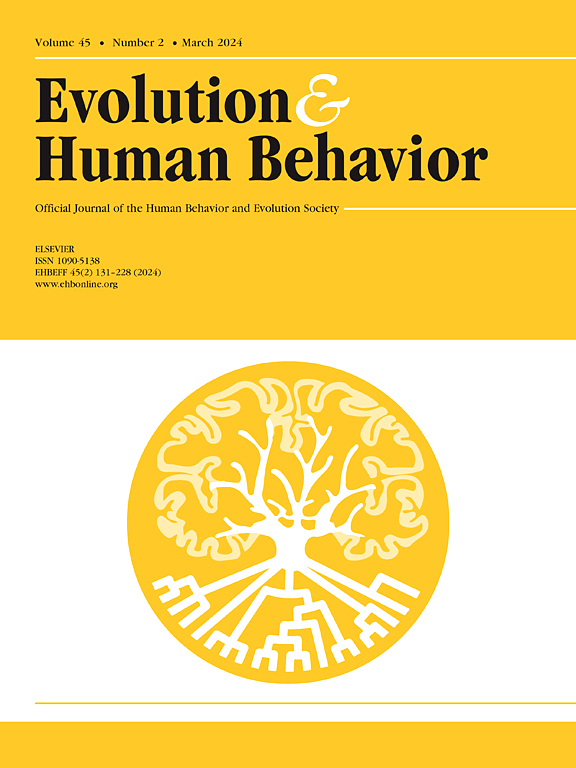Women's intrasexual competitiveness, but not fertility, predicts greater competitive behavior toward attractive women across the menstrual cycle
IF 3.2
1区 心理学
Q1 BEHAVIORAL SCIENCES
引用次数: 0
Abstract
Women compete for mates and social status, but little is known about the mechanisms that underlie these behaviors. Previous work suggests that mating competition should be most intense when women are fertile; thus, we hypothesized that women would exhibit more competitive behavior toward a high, rather than low, mating threat competitor during ovulation compared to other menstrual phases. Additionally, given that social support is crucial for women's access to resources and therefore offspring survival, we hypothesized that women would exhibit more competitive behavior toward a high, rather than low, social threat competitor following ovulation and possible conception. We tested 464 women recruited through social networking sites, psychology classes, and Prolific. Each rated their likelihood of exhibiting competitive behavior toward hypothetical mating and social competitors. Although women were more competitive toward the high, compared to low, mating and social threat competitors, there were no effects of cycle phase. Further, we found that intrasexual competitiveness, but not estimated hormones or other personality variables, predicted stronger competitive responses to the high mating threat competitor. We found no effects for social competitors. Together, these results suggest that in mating contexts, women's competition is dependent on individual tendency toward competition with other women, not fertility.
女性的性内竞争力,而不是生育能力,预示着在整个月经周期中,她们对漂亮女性的竞争行为更强
女性为配偶和社会地位而竞争,但人们对这些行为背后的机制知之甚少。先前的研究表明,当女性处于生育期时,交配竞争应该是最激烈的;因此,我们假设与其他月经期相比,女性在排卵期会表现出更多的竞争行为,而不是对交配威胁低的竞争对手。此外,考虑到社会支持对女性获得资源和后代生存至关重要,我们假设女性在排卵和可能受孕后,会对高社会威胁的竞争对手表现出更多的竞争行为,而不是低社会威胁的竞争对手。我们测试了通过社交网站、心理学课程和多产网站招募的464名女性。每个人都评估了他们对假想的配偶和社会竞争对手表现出竞争行为的可能性。尽管女性在追求高品质的竞争对手时比追求低品质的竞争对手更有竞争力,但生理周期并没有影响。此外,我们发现性内竞争,而不是估计激素或其他人格变量,预测对高交配威胁竞争者的更强竞争反应。我们没有发现对社会竞争者的影响。总之,这些结果表明,在交配环境中,女性的竞争取决于与其他女性竞争的个人倾向,而不是生育能力。
本文章由计算机程序翻译,如有差异,请以英文原文为准。
求助全文
约1分钟内获得全文
求助全文
来源期刊

Evolution and Human Behavior
生物-行为科学
CiteScore
8.30
自引率
9.80%
发文量
62
审稿时长
82 days
期刊介绍:
Evolution and Human Behavior is an interdisciplinary journal, presenting research reports and theory in which evolutionary perspectives are brought to bear on the study of human behavior. It is primarily a scientific journal, but submissions from scholars in the humanities are also encouraged. Papers reporting on theoretical and empirical work on other species will be welcome if their relevance to the human animal is apparent.
 求助内容:
求助内容: 应助结果提醒方式:
应助结果提醒方式:


